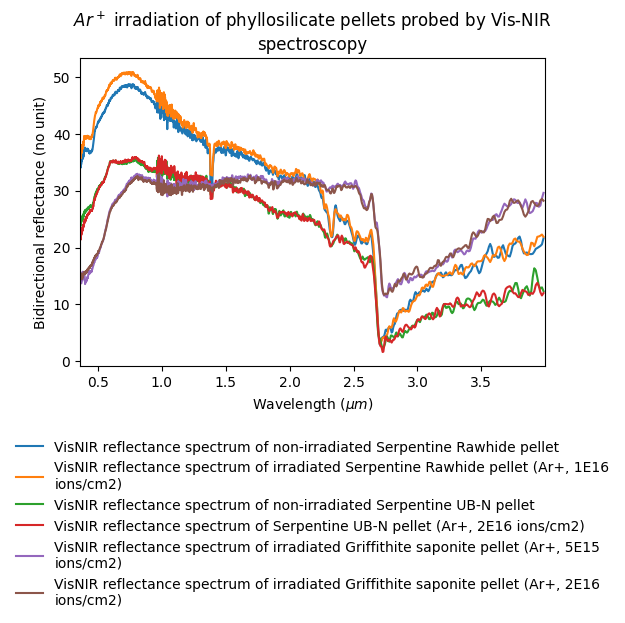- DOI
- 10.26302/SSHADE/EXPERIMENT_SR_20200204_03
- Data reference
- Rubino, Stefano (2020): $Ar^+$ irradiation of phyllosilicate pellets probed by Vis-NIR spectroscopy. SSHADE/DAYSY (OSUG Data Center). Dataset/Spectral Data. https://doi.org/10.26302/SSHADE/EXPERIMENT_SR_20200204_03
- Publications
- Database(s)
- Experimentalists
- Type(s)
- laboratory measurement
- Description
- Visible and Near-IR spectra of phyllosilicate pellets at different irradiation fluences of $Ar^+$ (40 keV).
- Number of spectra
- 12
- Variable type(s)
-
- sample composition
- irradiation dose
- Comments
- We irradiated pellets of different terrestrial phyllosilicates on the SIDONIE isotope separator at IJCLab (Orsay, France) using $Ar^+$ ions at 40 keV. Samples were mounted vertically and ion irradiation was performed at normal incidence. For each sample, we measured, besides the "virgin" spectrum, three separate spectra corresponding to different fluences: $5.10^{15}$, $1.10^{16}$ and $2.10^{16}$ $ions.cm^{-2}$.
- Laboratory
- Institut d'Astrophysique Spatiale (IAS)
- Standard medium
- vacuum
- Observation mode
- spectrum
- Spectral range type(s)
- Vis
- Valid spectral range(s)
-
Min - Max (${\mu}m$) Sampling (${\mu}m$) Resolution (${\mu}m$) Position accuracy (${\mu}m$) Absorption edge #1 0.35995 - 1.5 0.0005 1.0
Definition: incidence and emergence angles are positive with origin at nadir, and vary in same direction. Azimuth origin (increasing clockwise) is for i = e (opposition geometry).
- Observation geometry
- bidirectional
- Observation mode
- fixed angles
- Incidence angle
- 20.0°
- Emergence angle
- 15.0°
- Azimuth angle
- 0.0°
- Phase angle
- 20.0°
- Observation mode
- single spot
- Comments
- Collection spot size of 3-4 mm in diameter
- Instrument
- Bruker Tensor - reflection Near-IR
- Standard medium
- vacuum
- Observation mode
- spectrum
- Spectral range type(s)
- NIR
- Valid spectral range(s)
-
Min - Max (${\mu}m$) Sampling (${\mu}m$) Resolution (${\mu}m$) Position accuracy (${\mu}m$) Absorption edge #1 1.0 - 3.9989 0.0005 1.0
Definition: incidence and emergence angles are positive with origin at nadir, and vary in same direction. Azimuth origin (increasing clockwise) is for i = e (opposition geometry).
- Observation geometry
- bidirectional
- Observation mode
- fixed angles
- Incidence angle
- 20.0°
- Emergence angle
- 15.0°
- Azimuth angle
- 0.0°
- Phase angle
- 15.0°
- Observation mode
- single spot
- Comments
- Collection spot size of 3-4 mm in diameter
- Date begin
- 2020-02-04
Versions
- Release date
- 2022-06-06 12:36:06+0000 UTC
- Version (Date)
- #1 (2022-06-06 12:36:06+0000 UTC, Updated: 2022-07-08 09:10:13+0000 UTC)
